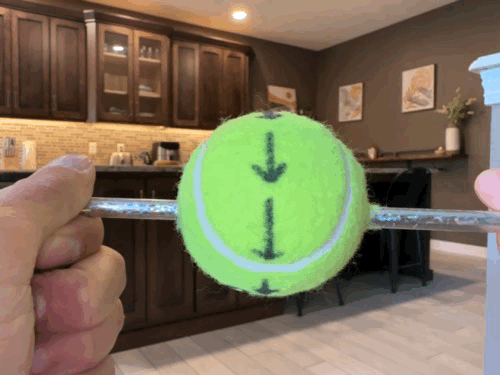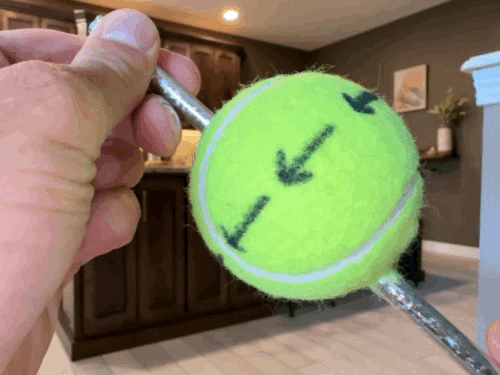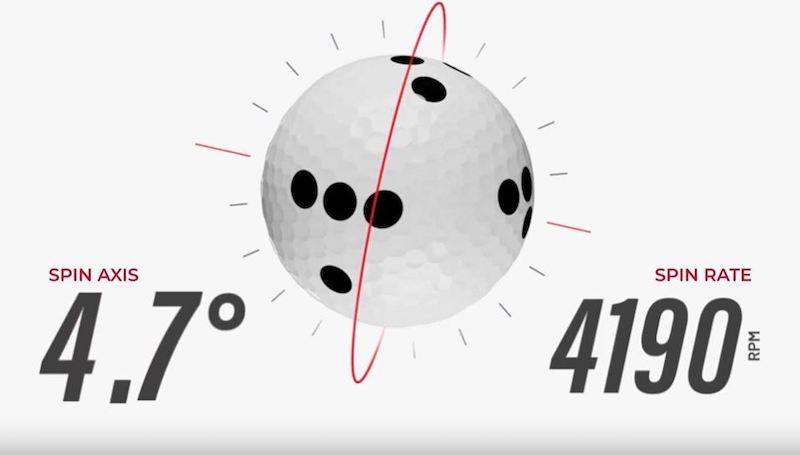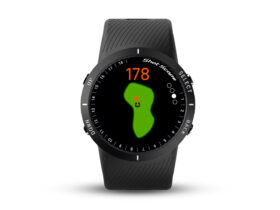Why Spin Axis Should Matter to You
It seems like the floodgates are opening and we are going to continue to see more and more affordable indoor launch monitor options every year. It’s a great time to be an indoor golfer. However, it’s important to know that these units aren’t all the same and some of their differences could mean big variations in how well they are able to determine what the golf ball is actually doing. It seems to be a point of contention with some people, but the truth is that radar units just can’t provide the same level of accuracy as camera-based (photometric) units do in an indoor setting. They function best when they can actually track a ball throughout a substantial portion of its flight. Even Trackman, the prize-winning Thoroughbred of radar launch monitors, seems to be conceding that fact with their new, camera-based indoor launch monitor systems. So, what is it that a camera (the high speed camera in the Rapsodo MLM2PRO, for example) does so well when it comes to predicting ball flight? Much of that answer is boiled down to the ability to measure spin rates and spin axis.

What is Spin Axis?
This is a topic that could easily span many more pages than we are able to devote to it, but we think we can explain it quickly in a way that makes sense.
First, we need to understand that a golf ball spins on single axis. Imagine a horizontal line parallel with the ground going through the center of the golf ball. Since we are striking the ball with a lofted club, it spins backwards on that axis. We, of course, call this backspin, measured in revolutions per minute (RPM). While some players may see upwards of 11,000 RPMs of backspin with a wedge, they may also see less than 2,000 with a driver. In the picture below, we see the ball spinning backwards along a horizontal axis (if you can kindly ignore the imperfect model I created).

Of course, we know that rarely does the ball spin perfectly backwards. Instead, golfers usually see curvature of some sort to their golf shots. While the full explanation of why that occurs is fascinating (read up on the D-Plane if you’re interested), we will keep it simple and say that a combination of your swing path and the club face’s angle at impact can cause the ball to stray from spinning perfectly backwards. Over the years, we’ve all grown familiar with the term “side spin”. It’s a common metric on almost any launch monitor that gives us an idea of whether our ball is moving left or right. However, there really isn’t such a thing as side spin. Rather, the axis the ball spins backwards on tilts, and we call this spin axis.
A perfectly horizontal axis is measured at 0 degrees, while the ball below is spinning on an axis tilted to the right, typically labeled as a positive number. In this case, the tilt is extreme for the sake of demonstration; likely close to 45 degrees. It would represent maybe the most impressive slice off the planet that anybody has ever seen.

Conversely, the ball below would illustrate a ball that moved in draw or hook shape, and we’d show the angle of the spin axis with a negative number. For the sake a conformity, we’ll just say this one is -45 degrees. Again, keep in mind that real world golf is going to (hopefully) see much smaller tilt angles than shown here.

Why Should You Care?
In truth, a large portion of the golfing public probably doesn’t need to care about spin axis. However, anybody considering an indoor launch monitor or simulator should consider its value before making a purchase. The truth is simple: If a launch monitor can’t measure spin axis and spin rates, its ability to display a realistic and accurate shot on a screen is compromised. We can add in all the necessary disclaimers there, because there are units that can calculate their way into acceptable windows of accuracy, but the truth remains. If you want to know what the ball is doing, it needs to be measured and radar really struggles to do that indoors. A photometric launch monitor that measures things like ball speed, starting direction, launch angle, back spin, and yes, spin axis, is going to be the most accurate option to track things like distance, shot shape, angle of descent, and dispersion.
Rapsodo and Callaway RPT Balls

Prior to 2023, options in the photometric arena weren’t really included in the low-cost portion of the market. Ranging from around $3,000 for a SkyTrak+ to close to $15,000 for Foresight’s GCQuad, they weren’t quite accessible enough to be considered “affordable”. Rapsodo managed to turn that reality on its head with its introduction of the MLM2PRO, which comes in around $700. While it’s not the lowest priced unit on the market, it’s the lowest priced unit that can boast its accuracy coming from photometric measurements.
It does this with the help of Callaway’s RPT (Rapsodo Precision Technology) golf balls. These are essentially normal Callaway Chrome Soft X balls marked with a series of dots that the MLM2PRO can measure with astounding accuracy. Callaway was able to leverage their existing expertise in golf ball marking they developed with the Truvis line. This partnership has enabled Rapsodo to punch far above their weight class in terms of accuracy, rivaling units close to 10 times the price.

According to Rapsodo, “Through our partnership with Callaway, we specially engineered balls using Callaway’s TruvisTechnology. These new golf balls are called, Callaway® RPT™ Chrome Soft X® Golf Balls and are designed with RapsodoPrecision Technology (RPT™) so the MLM2PRO™ can track the in-flight spin rate and spin axis of the ball. This allows you to receive spin measurements within 1% of the accuracy of high-priced launch monitors.”
The MLM2PRO isn’t perfect, and there are aspects of the device that remind us it’s a $700 launch monitor, but its reputation for accuracy really can’t be disputed. One complaint we’ve shared is that the RPT balls, while amazingly functional, are limited in scope. For example, those customers that would rather use a regular Chrome Soft don’t have that option at the moment. We aren’t alone in wishing Rapsodo and Callaway would expand the balls available with RPT markings. Maybe if we ask nicely again, we’ll get our wish.
What are your thoughts on spin axis and launch monitors? Come discuss the topic with thousands of other golfers on THP’s forum.












I enjoyed reading this. I think you presented a good explanation regarding spin and tilt.
So necessary for any kind of net practice when you can’t see ball flight.
Would there be any advantage using the RPT balls on the ST+?
Well this article comes at a good time for me.
I went into a Indoor Sim place that just opened up for business near my home.
It uses TrackMan for reading the golf ball.
The owner did tell me that on smaller chips or putts it uses a camera system.
They have ProV1 RCT golf balls for people to use, however I’m an “X” guy.
So when I was reading some of the numbers I was getting, I thought to myself “I know V1 is not a fit for me, too little spin”
If I’m going to go there more often, I’m going either have to get a sleeve of ProV1X RCT or a sleeve of the CSX RPT
This was a great article this morning for some reading material. The breakdown of spin axis was just enough for my brain to consume!
[QUOTE=”Iceman!, post: 11839473, member: 32688″]
Well this article comes at a good time for me.
I went into a Indoor Sim place that just opened up for business near my home.
It uses TrackMan for reading the golf ball.
The owner did tell me that on smaller chips or putts it uses a camera system.
They have ProV1 RCT golf balls for people to use, however I’m an “X” guy.
So when I was reading some of the numbers I was getting, I thought to myself “I know V1 is not a fit for me, too little spin”
If I’m going to go there more often, I’m going either have to get a sleeve of ProV1X RCT or a sleeve of the CSX RPT
[/QUOTE]
Im honestly not sure the RPT will offer much assistance on a Trackman indoors. It is designed to work with the Rapsodo cameras. Trackman is using radar to track the golf ball and calculating the information indoors based on that.
[QUOTE=”JB, post: 11839480, member: 3″]
Im honestly not sure the RPT will offer much assistance on a Trackman indoors. It is designed to work with the Rapsodo cameras. Trackman is using radar to track the golf ball and calculating the information indoors based on that.
[/QUOTE]
Thanks, good info. So would the CSX, RPT version, be a better option?
[QUOTE=”Iceman!, post: 11839499, member: 32688″]
Thanks, good info. So would the CSX, RPT version, be a better option?
[/QUOTE]
Im not sure I understand. Trackman isnt using a camera to pick up the RPT. As far as Trackman indoors, you either use the RCT from Titleist or deal with some funky numbers in our opinion (even then I would argue that they can get funky haha).
The data we now have at our fingertips with launch monitors and the seemingly endless choices of shafts and equipment can make for a time consuming search/obsession with the numbers. I do love that having accurate data can lead to trying different things with my swing and seeing how it changes the numbers. I’ve spent more time with an accurate LM the last few winters and for the first time in my life learned what swing changes are needed to spin my driver less. It’s still a work in progress but the PGA Superstore a mile from my house rents bays that include video and I plan on at least 20 sessions over the winter to get things dialed in.
It’s awesome that these launch monitors have become accurate enough without having to spend a sum that would buy a decent used car.
[QUOTE=”AuzzieMatt, post: 11839466, member: 54652″]
Would there be any advantage using the RPT balls on the ST+?
[/QUOTE]
No, because the Rapsodo algorithm is based on the RPT pattern. ST+ also measures spin axis, but uses markings on normal golf balls to accomplish this.
ST+, while it measures axis, uses that measurement to create and display the reading as “side spin” because it’s typically easier for people to understand. Nonetheless, the same benefit is there in terms of displaying ball flight accurately on the screen.
[QUOTE=”Iceman!, post: 11839473, member: 32688″]
Well this article comes at a good time for me.
I went into a Indoor Sim place that just opened up for business near my home.
It uses TrackMan for reading the golf ball.
The owner did tell me that on smaller chips or putts it uses a camera system.
They have ProV1 RCT golf balls for people to use, however I’m an “X” guy.
So when I was reading some of the numbers I was getting, I thought to myself “I know V1 is not a fit for me, too little spin”
If I’m going to go there more often, I’m going either have to get a sleeve of ProV1X RCT or a sleeve of the CSX RPT
[/QUOTE]
I’d just grab a sleeve of V1x RCT balls.
[QUOTE=”JB, post: 11839501, member: 3″]
Im not sure I understand. Trackman isnt using a camera to pick up the RPT. As far as Trackman indoors, you either use the RCT from Titleist or deal with some funky numbers in our opinion (even then I would argue that they can get funky haha).
[/QUOTE]
Thanks, I misunderstood your first comment.
I’ll pick up some V1X RCT golf balls.
Great write-up [USER=1193]@Hawk[/USER]. It’s much easier to do that troubleshooting on your own with a better understanding of how/why the ball is performing the way it is. Really impressive that the “lower-end” launch monitors now are capable of so much.
crazy fun way to explain spin axis!!!
Loved this, definitely needed information for the rise in indoor activities with golf.
Just so I understand [USER=1193]@Hawk[/USER] If you use the Rapsodo monitor but not the specially marked up Callaway balls then you can’t get the Spin Axis data? What about other data as well?
Spin axis is why I have an MLM2PRO as opposed to some others. I’m not in it too play sim golf. I need it to be accurate.
[QUOTE=”OldandStiff, post: 11840086, member: 53737″]
Spin axis is why I have an MLM2PRO as opposed to some others. I’m not in it too play sim golf. I need it to be accurate.
[/QUOTE]
Do you not find Trackman accurate?
[QUOTE=”smgoldstein, post: 11840114, member: 4509″]
Do you not find Trackman accurate?
[/QUOTE]
With the right setup and a boatload more money spent, sure.
Like mentioned in the article though for [I]indoor [/I]space they’ve kind of showed that even they believe camera integration is necessary for best functionality.
but really the most important part is the software that interprets the camera’s input.
if the numbers and or algorithms are bad, the information is bad.
Good article and something important to pay attention to for those who have the units that measure it and practice at home. Paying close attention to the spin axis helped me understand what’s going on with my swing and push me in the right direction so to speak for making corrections.
[QUOTE=”smgoldstein, post: 11840047, member: 4509″]
Just so I understand [USER=1193]@Hawk[/USER] If you use the Rapsodo monitor but not the specially marked up Callaway balls then you can’t get the Spin Axis data? What about other data as well?
[/QUOTE]
This is correct. There are some metrics is provides without the RPT balls, but it’s very limited.
[QUOTE=”smgoldstein, post: 11840047, member: 4509″]
Just so I understand [USER=1193]@Hawk[/USER] If you use the Rapsodo monitor but not the specially marked up Callaway balls then you can’t get the Spin Axis data? What about other data as well?
[/QUOTE]
Ball speed, launch angles directions, etc. normal but for an accurate picture of the shot you need the rest. You don’t need the Callaway balls though. It can be debated but there’s effective work around with the aftermarket Rapsodo balls dots.
Great writeup – think it really helps for folks thinking or considering getting a launch monitor. Obviously for indoor setups, Foresight has the de facto standard for photo metric but SkyTrak is soo good for the price point!
As I’m sitting here I’m wondering about spin axis on the GC3. Could there be a difference based on which way the logo is placed or marking on the ball if it has one?
[QUOTE=”Mmaynard11, post: 11840396, member: 19877″]
As I’m sitting here I’m wondering about spin axis on the GC3. Could there be a difference based on which way the logo is placed or marking on the ball if it has one?
[/QUOTE]
Not really. If it gives people peace of mind, line the logo there
[QUOTE=”Mmaynard11, post: 11840396, member: 19877″]
As I’m sitting here I’m wondering about spin axis on the GC3. Could there be a difference based on which way the logo is placed or marking on the ball if it has one?
[/QUOTE]
I’m sure they have nailed that down.
[QUOTE=”JB, post: 11840477, member: 3″]
Not really. If it gives people peace of mind, line the logo there
[/QUOTE]
[QUOTE=”Hawk, post: 11840500, member: 1193″]
I’m sure they have nailed that down.
[/QUOTE]
I didn’t think so but thought I would ask. Appreciate the info!!!
That was so damn interesting!
[QUOTE=”puffBoss, post: 11928787, member: 77283″]
As a person who’s done extensive research on all the products in the market, I completely vouch for this article. Trackman is overrated in the indoor set up. Not saying it’s bad, but for the accuracy, you have far more cost effective options just because Trackman would have to estimate the rest of the ball’s trajectory after few feets just as much as photometric ones like QED. Then, now it’s just the realm of physics research and the trajectory algorithm each product employs.
[/QUOTE]
Thanks for the post.